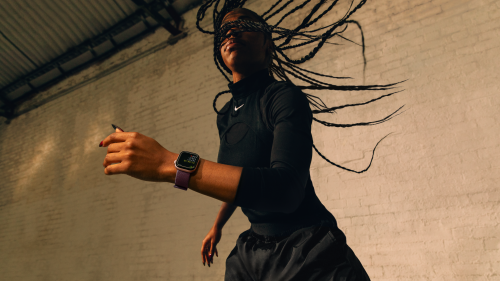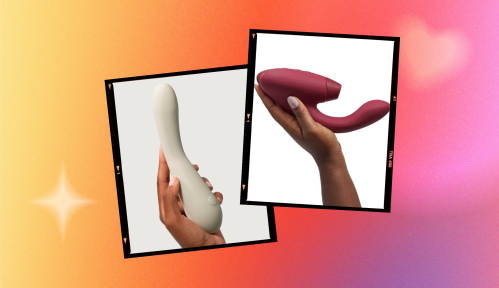This April, Apple Watch will be celebrating its 10th anniversary—safe to say, time flies. What originally started as a luxury smartwatch that allowed you to check your calls, messages, and emails quickly turned into a wearable device that gives you access to your health data at your fingertips.
Experts in This Article
vice president of health at Apple
Since its inception, Apple has released 15 iterations of the watch, each surpassing the previous generation's features and functionality. And all of these upgrades have continued to revolutionize how we interact with our health information and adjust our lifestyles to promote personal well-being. If you're one of the hundreds of millions of people around the world who owns an Apple Watch, you've likely been excited to close your rings, hit your daily step count, or accomplish one of the many health and fitness goals the watch tracks.
But these metrics weren't always available from the beginning. It took years of in-depth research and statistically significant findings to implement accurate and user-friendly features. So we sat down with Sumbul Desai, MD, vice president of health at Apple, to turn back the clock and really understand the evolution of Apple Watch and how this small device has made big strides in empowering people to take the reins over their health.
Where it's been
When we think about new technology, it's important to ask the questions: Why this and why now? What made Apple Watch so fascinating in 2015—aside from how cool it looked on your wrist—was its ability to let you stay connected to the world, enhance productivity (because you probably weren't checking your phone all the time), and seamlessly integrate all of your data across any Apple device you owned.
But, the health and fitness metrics were the icing on the cake. Rather than waiting for a doctor's appointment that could be months away, Apple Watch allowed you to gain better, and more immediate, insights about your health. "We're not looking to replace doctors," Dr. Desai clarifies. "We're actually looking to enhance your relationship with them, so you can be in the driver's seat and advocate for the things you need."
How many times have you seen your healthcare provider and been asked questions about your sleep habits or exercise routines? The answer, for most of us, is likely every single time you go in for an appointment. But let's be real, the busyness of life doesn't always allow time for everyone to keep a robust journal tracking how many hours they slept, what exercises they did that week, or the exact number of steps they walked that day. Enter: Apple Watch—the device that let you put away the paper and pens and do the work for you so the next time you were asked those questions, you had reliable answers.
"Apple Watch filled an information gap," Dr. Desai explains. The journey started organically through fitness. "We asked ourselves how can we use Apple Watch to motivate people to stay active," Dr. Desai says. "We had this idea of letting people close their rings and maybe even track their workouts." The optical heart sensor on the first version of the watch allowed you to track three basic metrics, which eventually turned into the "rings" we know and love today: Move, Exercise, and Stand.
And once Apple saw success with these features, they were eager to do more and more in-depth research to implement new and scientifically backed ways to give you more access to your health information. "We started with heart rate, and then we did like high heart rate and low heart rate. We added rhythm notifications for atrial fibrillation," Dr. Desai explains. "Then we introduced the blood oxygen and the temperature sensors."
While each functionality snowballed into the next, it's important to note these features didn't magically appear out of thin air. Dr. Desai explains that every single one of their additions requires several clinical studies that roughly take anywhere from two to five years to complete. "We need to ensure accuracy and once we feel good about it, that's when we add it to the product," she adds.
Over the past 10 years, Apple has added several features that enable users to learn more about their health and fitness journeys. These include, but are not limited to:
- Activity rings
- Workout tracking
- Activity sharing
- Heart rate
- HIIT workouts
- Current elevation
- Cycle tracking
- Loud noise alerts
- Sleep stages
- Handwashing
- Cardio fitness
- Mindfulness
- Time in daylight
- Vitals app
And we have no doubt that more exciting features are on the way.
Where its impact is now
From the beginning, Apple's goal with the watch was simple: How can this device enrich your life? But when it comes to the health tracking of it all, Dr. Desai explains that they wanted to keep science at the core to help individuals get accurate and reliable information. "The engineering and the science behind the creation of the watch didn't just let you know about your health, it empowered you to use that information to take actionable steps," she says.
And today, we know that holds true. We asked Dr. Desai about any anecdotes Apple Watch users had shared with her about how the watch has impacted their health—and here's what she had to say:
"One story that's always stayed with me is about a woman who received a higher heart rate notification while she was pregnant," she says. The woman ended up going to the hospital because of that notification and got diagnosed with thyroid storm—a life-threatening condition that occurs when there's a rapid and uncontrollable increase of thyroid hormone levels. "She was admitted into the ICU, and had she not gotten there when she did, she would have lost both her life and her unborn child's life."
More recently, Dr. Desai talked about another woman who shared her story about how the Vitals App (aka the feature that tracks all sorts of vitals such as heart rate, breathing, and sleep disturbances all in one place) saved her life. "The woman noticed some changes in her vitals over a few days and ended up going to her doctor," Dr. Desai says. "She underwent testing and was diagnosed with blood cancer." Without these subtle changes in her vitals, she may have not otherwise known there was anything going on in her body, and knowing that information is powerful.
But these aren't the only stories out there about the Apple Watch's impact on health. Last year, one Redditor posted that "the vitals app knew I was sick 3 days before I did." The post included a screenshot of the Redditor's Vitals App data, which showed some outliers in their health data over the past several days. Sure enough, the Redditor explained that they "woke up feeling off" and realized they were sick. People in the comments agreed that the Vitals App helped them notice changes in their health metrics before they even experienced symptoms.
And if you're still not convinced, then maybe you'll believe the person who is writing this story (hi, yes, that's me). Last year, I started getting high heart rate notifications on my Apple Watch for weeks. But because of who I am as a person, I was too nervous to go to the doctor. So instead of reaching out to my primary care provider, I decided that walking more and meditating could help keep my heart rate in my normal range.
Sure, these lifestyle changes helped for a while. But when I noticed that my heart rate was consistently getting higher, it was finally time to make an appointment with a cardiologist. Long story short, I ended up being diagnosed with sinus tachycardia—just a fancy way of describing a heart rate higher than 100 beats per minute which is often caused by stress. Don't worry, I got treatment and I'm doing much better now. But because I don't count my heartbeats manually, I probably wouldn't have known anything was wrong had I not been wearing my watch.
Today, Apple Watch isn't just a fashionable accessory, it's become a 24/7 companion that sends you important health information, keeps you motivated, and holds you accountable—whether that's reminding you to walk around, take your medication, or get in a quick meditation session. In an era where healthcare may not be as inclusive and accessible as we hope it would be, this device has truly redefined how health technology can proactively supplement your well-being in your everyday life.
Where it's headed next
Over the last 10 years, Apple Watch features have generated access to real-time data and eye-opening information that have transformed the way we all receive and process our personal health. While we don't the know the exact details of what's going on behind the scenes at Apple, Dr. Desai was able to give us some insights about the direction Apple Watch may be heading.
"We're always looking at ways where we can discover something new about your health status," she explains. "Most people often go to the doctor once something has already happened. We want to try to get ahead of that and focus on features that can support proactivity and prevention."
You'll likely find out the news about the next Apple Watch release and latest features the same time we do. But in the near future, you can expect something fun. On April 24, Apple is celebrating its 10-year anniversary with Global Close Your Rings Day. The intention of this day is to encourage Apple Watch users to do an activity they love or try something new to close your rings. Those who close their rings that day will earn a limited edition reward, plus animated stickers, an animated badge, and a special pin that you can pick up at your local Apple Store while supplies last. So what are you waiting for? Be ready to get moving and close those rings!
Sign Up for Our Daily Newsletter
Get all the latest in wellness, trends, food, fitness, beauty, and more delivered right to your inbox.
Got it, you've been added to our email list.









